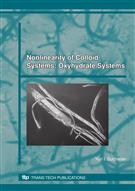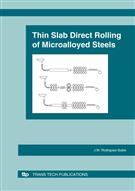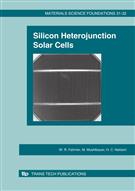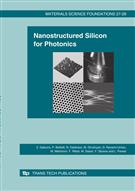Engineering Research
Advanced Engineering Forum
Applied Mechanics and Materials
Engineering Chemistry
Engineering Innovations
Journal of Biomimetics, Biomaterials and Biomedical Engineering
International Journal of Engineering Research in Africa
Materials Science
Advanced Materials Research
Defect and Diffusion Forum
Diffusion Foundations and Materials Applications
Journal of Metastable and Nanocrystalline Materials
Journal of Nano Research
Key Engineering Materials
Materials Science Forum
Nano Hybrids and Composites
Solid State Phenomena
Engineering Series
Advances in Science and Technology
Construction Technologies and Architecture
Engineering Headway
Foundations of Materials Science and Engineering
Volume in the series: 41-43
Authors:
W. Ahmed, N. Ali and Prof. Andreas Öchsner
Biomedical engineering involves the application of the principles and techniques of engineering to the enhancement of medical science as applied to humans or animals. It involves an interdisciplinary approach which combines the materials, mechanics, design, modelling and problem-solving skills employed in engineering with medical and biological sciences so as to improve the health, lifestyle and quality-of-life of individuals. Biomedical engineering is a relatively new field, and involves a whole spectrum of disciplines covering: bioinformatics, medical imaging, image processing, physiological signal processing, biomechanics, biomaterials and bioengineering, systems analysis, 3-D modelling, etc. Combining these disciplines, systematically and synergistically yields total benefits which are much greater than the sum of the individual components. Prime examples of the successful application of biomedical engineering include the development and manufacture of biocompatible prostheses, medical devices, diagnostic devices and imaging equipment and pharmaceutical drugs.
The purpose of this book is to present the latest research and development carried out in the areas of biomedical engineering, biomaterials and nanomaterials science and to highlight the applications of such systems. Particular emphasis is given to the convergence of nano-scale effects, as related to the delivery of enhanced biofunctionality.
The purpose of this book is to present the latest research and development carried out in the areas of biomedical engineering, biomaterials and nanomaterials science and to highlight the applications of such systems. Particular emphasis is given to the convergence of nano-scale effects, as related to the delivery of enhanced biofunctionality.
eBook:
$198.00
Volume in the series: 40
Authors:
Young Kyoo Kim and Chang Sik Ha
Organic electroluminescence (OEL) is the phenomenon of electrically-driven emission of light from organic materials; including both fluorescent and phosphorescent organic solids. The organic light-emitting device (OLED), which exploits OEL emission from organic semiconducting thin films (with thicknesses of less than a few hundred nanometers), sandwiched between electrodes, has attracted keen interest in its application to flat-panel displays, due to its high luminous efficiency, low driving voltage, tunable colors as well as a convenient device-structure design and low fabrication costs when compared with every other known display device.
eBook:
$138.00
Volume in the series: 39
Authors:
Gerhard Kloos
eBook:
$138.00
Volume in the series: 38
Authors:
Gouri Cheruvally
Since the first development of lithium-ion batteries in the early 1990’s, there have been tremendous advances in the science and technology of these electrochemical energy sources. At present, lithium batteries dominate the field of advanced power sources and have almost entirely replaced their bulkier and less energetic counterparts such as nickel-cadmium and nickel-metalhydride batteries; especially in portable electronic devices. But lithium batteries are still the object of continuing intense research aimed at making further improvements in performance and safety, at lower cost, so as to make them suitable for higher-power and more demanding applications such as electric vehicles. The research and development of new electrode materials, particularly for cathodes, having an improved electrochemical performance has always been a matter of changing focus. Thus, olivine, lithium iron phosphate, has attracted considerable attention in recent years as a safe, environmentally friendly, extremely stable and very promising cathode material.
eBook:
$138.00
Volume in the series: 36-37
Authors:
Pierre SARRAZIN, Alain GALERIE, Jacques FOULETIER
The oxidation of metals is, by definition, a reaction between a gas and a solid which usually produces a solid reaction product. At first glance, this would therefore seem to be a very simple process but, in fact, it is considerably more complex. One would like to think that the reaction product, i.e., the scale that forms on the metal, acts as a physical barrier between the reactants, and that the reaction should thus cease once the barrier is established. We know that this is unfortunately not the case, because transport of matter through the scale allows the reaction to continue. We also know that, because of density-differences between the metal and its oxide, the scale may not be sufficiently complete in coverage or may not adhere to the substrate because of cracking, spalling and detachment (wrinkling). In some extreme cases, the scale may even be a liquid which simply drips from the surface, or it may volatilize at operational temperatures. The reaction between a gas and a metal is truly very complicated.
eBook:
$182.00
Volume in the series: 34-35
Authors:
Yuri I. Sucharev
The present monograph is the first systematic study of the non-linear characteristic of gel oxy-hydrate systems involving d- and f- elements. These are the oxyhydrates of rare-earth elements and oxides – hydroxides of d- elements (zirconium, niobium, titanium, etc.) The non-linearity of these gel systems introduces fundamental peculiarities into their structure and, consequently, their properties.
eBook:
$193.00
Volume in the series: 33
Authors:
J.M. Rodriguez-Ibabe
Thin slab casting and direct rolling (TSDR) technologies are nowadays one of the most promising processing routes to maintain steel as a leading material in technological applications. Initially, this process was exclusively for the production of mild steels. As industrial experience and knowledge improved, a rapid expansion of the range of products took place with higher strength grades becoming an important part of the overall production. Actually, it is widely accepted as a route to produce high value grades and it can be considered as a technology which has reached a high degree of maturity. This book aims to provide an approach to the different metallurgical aspects involved in the application of thermomechanical treatments in the TSDR route.
eBook:
$88.00
Volume in the series: 31-32
Authors:
W.R. Fahrner, M. Muehlbauer and H.C. Neitzert
The world of today must face up to two contradictory energy problems: on the one hand, there is the sharply growing consumer demand in countries such as China and India. On the other hand, natural resources are dwindling. Moreover, many of those countries which still possess substantial gas and oil supplies are politically unstable. As a result, renewable natural energy sources have received great attention. Among these, solar-cell technology is one of the most promising candidates. However, there still remains the problem of the manufacturing costs of such cells. Many attempts have been made to reduce the production costs of “conventional” solar cells (manufactured from monocrystalline silicon using diffusion methods) by instead using cheaper grades of silicon, and simpler pn-junction fabrication. That is the ‘hero’ of this book; the heterojunction solar cell.
eBook:
$171.00
Volume in the series: 29-30
Authors:
Pentti O. Kettunen
One of the oldest construction materials is wood which, technically speaking, belongs to the group of polymer matrix composites; one which is conveniently and expertly produced by Nature. Due to its organic cell-type structure, the density of wood remains modest. Thus, as its strength and stiffness can - in certain cases - attain remarkable values, its levels of specific strength and stiffness (absolute strength or stiffness divided by density) can reach magnitudes which are competitive with those of other construction materials. It is demonstrated, for instance, that the specific strength of wood in the axial direction can exceed those of low-carbon steel and concrete. Its specific stiffness can also be comparable to those of aluminum alloys and low-carbon steels, and is better than that of concrete. In constructional design, especially in the dimensioning of supports, the values of specific strength and stiffness are of utmost importance.
eBook:
$198.00
Volume in the series: 27-28
Authors:
Z. Gaburro, P. Bettotti, N. Daldosso, M. Ghulinyan, D. Navarro-Urrios, M. Melchiorri, F. Riboli, M. Saiani, F. Sbrana and L. Pavesi
The use of light to channel signals around electronic chips could solve several current problems in microelectronic evolution including: power dissipation, interconnect bottlenecks, input/output from/to optical communication channels, poor signal bandwidth, etc. It is unfortunate that silicon is not a good photonic material: it has a poor light-emission efficiency and exhibits a negligible electro-optical effect. Silicon photonics is a field having the objective of improving the physical properties of silicon; thus turning it into a photonic material and permitting the full convergence of electronics and photonics.
eBook:
$171.00









